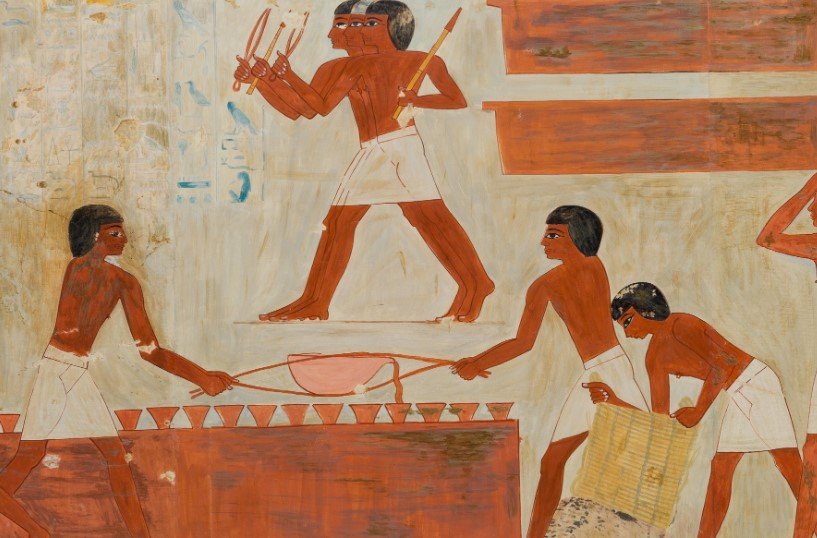Archaeologists have uncovered the first direct evidence of advanced arsenical bronze production in ancient Egypt, dating back to the Middle Kingdom around 2000 to 1650 BCE. The discovery on Elephantine Island near Aswan shows skilled metallurgists used a special alloy called speiss to create stronger tools and weapons, reshaping our view of early Egyptian technology.
Groundbreaking Find on Elephantine Island
A team of international researchers analyzed metalworking remains from Elephantine Island, an ancient site in the Nile River near Aswan. Their study, published in the journal Archaeometry in 2025, reveals that Egyptian craftsmen intentionally added arsenic to copper using speiss, a slag-like material rich in arsenic, iron, and lead.
This evidence comes from slags found in ceramic crucibles, proving a controlled process rather than accidental traces from ore. The work was part of a project led by the German Archaeological Institute, with approvals from Egyptian authorities.
Excavations uncovered these materials in areas tied to daily life, showing metallurgy was integrated into community activities during the Middle Kingdom, a period of prosperity and innovation in Egypt.
The team used advanced lab techniques to examine the composition, confirming speiss as a deliberate ingredient. This find dates to a time when Egypt was building grand temples and expanding trade.
Understanding Arsenical Bronze and Speiss
Arsenical bronze is an alloy of copper and arsenic that makes metal harder and more durable than pure copper. It was vital for tools, weapons, and everyday items in ancient societies.
Speiss, often seen as a by-product in smelting, was used here on purpose to boost arsenic levels. The study found speiss with several percent lead, adding complexity to how these alloys formed.

Unlike tin bronze, which came later, arsenical versions relied on local resources. This method improved casting and reduced brittleness, key for practical use.
Researchers noted that this technique likely spread through knowledge sharing among craftsmen, highlighting Egypt’s role in early metallurgy.
How This Changes Views on Egyptian Metallurgy
For years, experts thought arsenical copper in Egypt came from natural ore impurities. This new evidence proves intentional alloying, showing advanced skills by the early second millennium BCE.
It suggests Egyptian metallurgists understood chemistry better than previously thought, controlling reactions in crucibles heated to high temperatures.
This innovation happened before widespread tin use, during a time of political stability under pharaohs like Amenemhat III. It ties into broader advancements in architecture and art.
The discovery also links to earlier fragments, hinting at even older practices that future studies will explore.
Experts say this could rewrite textbooks on ancient technology, emphasizing Egypt’s ingenuity.
Trade Networks and Resource Origins
The presence of speiss points to organized trade or sourcing. Arsenopyrites, possible sources for speiss, are found in Egypt’s Eastern Desert.
Craftsmen might have obtained materials from local desert groups or expeditions, indicating early supply chains.
This affects provenance studies, as lead in speiss can alter isotope readings used to trace metal origins.
Similar techniques appear in other regions, like the Levant and Mesopotamia, suggesting cultural exchanges.
During the Middle Kingdom, Egypt traded with Nubia and the Levant, bringing in goods that fueled such innovations.
Here’s a quick look at potential resource flows:
- Eastern Desert: Likely source of arsenopyrites for speiss production.
- Sinai Peninsula: Known for copper mines, possibly linked to Elephantine operations.
- Nubian Regions: Provided gold and other metals, supporting alloy experiments.
- Levant Connections: Shared metallurgy knowledge, influencing Egyptian methods.
Insights from the Research Team
Lead researcher Jiří Kmošek explained that speiss integration shows deep process knowledge. Co-author Martin Odler noted it alters perceptions of Egyptian tech, with evidence of earlier speiss use.
The team collaborated with French and Egyptian institutes for lab access, ensuring thorough analysis.
This work builds on recent finds, like copper smelting sites in Sinai from 2025 excavations, showing ongoing metallurgical activity across periods.
It connects to global studies on Bronze Age alloys, such as those in Sardinia revealing Iberian trade links.
Wider Impact on Ancient History
This discovery fits into a timeline of metallurgical evolution in Egypt, from early copper use in the Old Kingdom to bronze dominance.
| Period | Key Metallurgy Development | Location Example |
|---|---|---|
| Old Kingdom (c. 2686-2181 BCE) | Basic copper tools with natural arsenic | Giza workshops |
| Middle Kingdom (c. 2000-1650 BCE) | Intentional arsenical bronze via speiss | Elephantine Island |
| New Kingdom (c. 1550-1070 BCE) | Widespread tin bronze adoption | Thebes and trade hubs |
| Late Period (c. 664-332 BCE) | Advanced alloys with imported materials | Sinai smelting sites |
It challenges ideas of technological progress, showing Egypt was not isolated but part of wider networks.
Recent 2025 studies on Sumerian and Sardinian bronzes echo these findings, underlining shared ancient innovations.
As research continues, it may reveal more about how these techniques influenced daily life and warfare.
What do you think about this glimpse into ancient Egyptian ingenuity? Share your thoughts in the comments and spread the word to fellow history enthusiasts.
